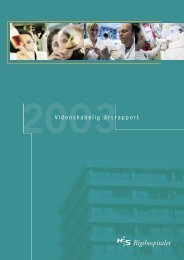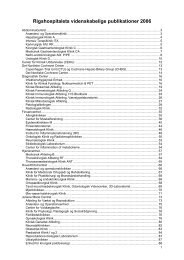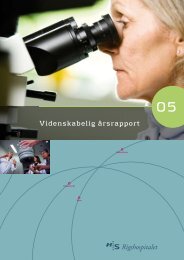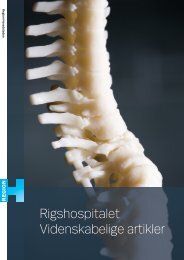View - CTU
View - CTU
View - CTU
You also want an ePaper? Increase the reach of your titles
YUMPU automatically turns print PDFs into web optimized ePapers that Google loves.
The adoption of new endodontic technology<br />
amongst Danish general dental practitioners<br />
L. Bjerndal 1 & C. Reit 2<br />
1 Department of Cariology and Endodontics, University of Copenhagen, Copenhagen, Denmark; and 2 Department of End d _<br />
tology, Faculty of Odontology, Sahlgrenska Academy at Giiteborg University, Giiteborg, Sweden<br />
° on<br />
Abstract<br />
Bjarndal L, Reit C. The adoption of new endodontic technology<br />
amongst Danish general dental practitioners. International<br />
Endodontic Journal, 38, 52-58, 2005.<br />
Aim To assess the adoption of new endodontic technology<br />
in a population of Danish practitioners.<br />
Methodology Members of the Copenhagen Dental<br />
Association (11 = 1156) were approached with a questionnaire<br />
concerning the frequency of various endodontic<br />
procedures. Three options were available: often,<br />
occasionally and never. Responses were anonymous.<br />
The statistical analyses were performed as studies of<br />
association in two- or three-way contingency tables,<br />
and with Goodman-Kruskal' s y-coefficient as the basic<br />
tool chosen.<br />
Results Only data from general practitioners (GPs)<br />
in private practice were analysed (11 = 956). The<br />
response rate was 72%. NiTi hand instruments were<br />
often used to negotiate canals by 18%, whilst 10%<br />
often used NiTi rotary systems. Electronic apex<br />
locators were often employed by 15%. Nineteen per<br />
cent reported that warm gutta-Percha was often used.<br />
A majority (53%) often spend two sessions to instrument<br />
a molar, and 20% often needed three or more<br />
sessions to finish the shaping Phase. To complete a<br />
treatment of a non vital case most practitioners reported<br />
to use at least three appointments. Only 4%<br />
frequently applied rubber dam.<br />
Conclusions The adoption of new endodontic technology<br />
is at an early stage amongst Danish GPs. A new<br />
revised remuneration system might influence the rate<br />
of adoption, allowing the practitioners to act more<br />
rationally and produce a higher frequency of goodquality<br />
root fillings. Progress towards high quality<br />
endodontics might be hindered by the nonuse of rubber<br />
dam.<br />
Keywords: adoption of technology, electronic apex<br />
locators, NiTi instruments, rubber dam, treatment<br />
sessions, warm gutta-percha.<br />
Received 2 February 2004; accepted I 4 October 2004<br />
m<br />
Introduction<br />
In a recent study using a nationwide database, Bj0rndal<br />
& Reit (2004) reported a 17% increase in the annual<br />
frequency of root fillings performed in Danish adults<br />
between 1977 and 2003. Thus, the need and demand<br />
for endodontic therapy does not necessarily appear to<br />
decrease in a population with a low prevalence of caries,<br />
However, endodontics is one of the most technically<br />
challenging clinical procedures and the quality of the<br />
Correspondence: Lars Bjorndal, Department of Cariology and<br />
Endodontics, Faculty of Health Sciences, Norre Alle 20, DK-<br />
2200 Copenhagen N, Denmark (Tel.: +45 35326814; fax:<br />
+45 35326505; e-mail: lb@odont.ku.dk).<br />
International Endodontic Journal, 38, 52-58, 2005<br />
treatment provided in general dental practice has been<br />
questioned. For example, in a radiographic examination<br />
of randomly selected individuals from Aarhus,<br />
Denmark, Kirkevang et al. (2000) observed that 59%<br />
of the root filled teeth had inadequate lateral seal and<br />
40% displayed inadequate length. Furthermore, 5 2 % of<br />
the treated teeth were associated with signs of apical<br />
periodontitis. These data are part of a body of evidence<br />
demonstrating, in most populations, a high frequency of<br />
technically defective root fillings, a high prevalence of<br />
periapical radiolucencies in root filled teeth, and a<br />
strong correlation between the two (Eriksen et al. 2002,<br />
Dugas et al. 2003).<br />
Despite the high rate of substandard treatments<br />
reported, few studies have been concerned with factors<br />
© 2005 International Endodontic Journal








